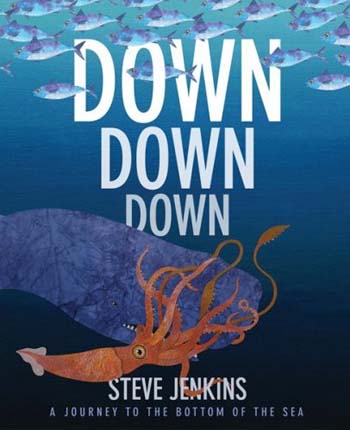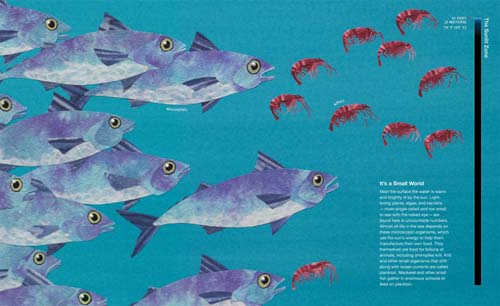No One Does the Food Chain Quite Like Steve Jenkins
 April 20th, 2009 by jules
April 20th, 2009 by jules
I’ve posted here at 7-Imp about author/illustrator Steve Jenkins and his torn- and cut-paper collages several times before, including this interview from over a year ago. I’ve made my fondness for his books quite clear. When I asked him recently if he could share some spreads from his new title, he said yes. Lucky me, because I love this book. It’s called Down Down Down: A Journey to the Bottom of the Sea (to be released in early May by Houghton Mifflin), and just when I thought that Steve’s books couldn’t possibly get any better or more interesting…
Viewed from space, the earth looks like a watery blue ball. Oceans cover more than two-thirds of the globe’s surface, and well over half the planet lies beneath water more than a mile…deep. We have explored only a fraction of the oceans. In fact, more humans have walked on the moon than have visited the deepest spot in the sea.
 This is how Jenkins opens the book, then telling us we’ll be descending from the surface of the ocean to the sea floor, travelling through “one of the most extreme environments on earth.” In fact, in the next spread we see that he actually begins above the surface, showing us that sometimes, “without warning, the creatures of this hidden world burst into our own…sea creatures sometimes leap from the water into the air…” (great white shark, flying squid, spinner dolphin, etc.) Indeed, he eventually takes us to the deepest spot in the sea, in which almost seven miles of water rest above our heads, to the Challenger Deep. In between, he puts to use his usual charms on each and every spread: His richly-textured images and detailed visual data, as well as his ability to lay out sea-life facts in an engaging manner, appealing to a wide variety of ages. (My own very young children, who are drawn to Jenkins’ titles like candy, actually use the book as a toy—though we’ve read it precisely seven bajillion times, too—putting their small dinosaur creatures on the book’s sea spreads to interact with the ogrefish, goblin sharks, deep-sea jellyfish, and giant squids.) My favorite fun fact? Bioluminescence—when animals can produce their own light, as most of the sea life that live below the sunlit layer of the ocean do—is the most common form of animal communication on earth. Who knew.
This is how Jenkins opens the book, then telling us we’ll be descending from the surface of the ocean to the sea floor, travelling through “one of the most extreme environments on earth.” In fact, in the next spread we see that he actually begins above the surface, showing us that sometimes, “without warning, the creatures of this hidden world burst into our own…sea creatures sometimes leap from the water into the air…” (great white shark, flying squid, spinner dolphin, etc.) Indeed, he eventually takes us to the deepest spot in the sea, in which almost seven miles of water rest above our heads, to the Challenger Deep. In between, he puts to use his usual charms on each and every spread: His richly-textured images and detailed visual data, as well as his ability to lay out sea-life facts in an engaging manner, appealing to a wide variety of ages. (My own very young children, who are drawn to Jenkins’ titles like candy, actually use the book as a toy—though we’ve read it precisely seven bajillion times, too—putting their small dinosaur creatures on the book’s sea spreads to interact with the ogrefish, goblin sharks, deep-sea jellyfish, and giant squids.) My favorite fun fact? Bioluminescence—when animals can produce their own light, as most of the sea life that live below the sunlit layer of the ocean do—is the most common form of animal communication on earth. Who knew.
As usual, Jenkins closes the book with facts about each animal for further reading, but the neatest part of this title is that on the right of each spread, he includes a to-scale representation of the ocean’s depth—and our location in that scale on each spread. It’s just flat-out cool, my friends. But you can see that for yourself here, since Steve sent some spreads from the title to share. I thank him for doing so; now you can see for yourself what he can do with his paper collages. Click on each spread to see it way bigger and up close and personal.
Anyone else remember in that February ’08 interview when Little Willow asked Jenkins what personally intrigues him and which he’s yet to make a book topic — and one of his responses was “how the world might end”? Ooo! Ooo! I’m still waiting for that one.
DOWN DOWN DOWN: A JOURNEY TO THE BOTTOM OF THE SEA © 2009 Steve Jenkins. Published by Houghton Mifflin Books for Children, Boston. Posted with permission of Jenkins. All rights reserved.
If you want to read about other nonfiction titles today, the Nonfiction Monday round-up is over at Mommy’s Favorite Children’s Books.







There’s a dreaminess to these illustrations as well as a scientific precision. Lovely.
That looks amaaaazing.
I can’t wait to see this one in person. I am never going to be a diver, on account of the idea of not breathing air freely in a place where there is a lot of it just FREAKS ME OUT, but under the water is like another planet. So cool.
Thank you for this journey into an eerily beautiful world.
Now, THIS is one seriously cool-looking book.
(And, duh, while I knew about the glowing fish and spitting shrimp and so on, I had NO IDEA that their stomping grounds are at such relatively shallow depths — pictured them swimming along, like, a foot above the seabed. Those “to-scale representation[s] of the ocean’s depth” you mentioned left me speechless!)
I noticed the naming convention for those images; are those page numbers, or two-page spread numbers? (Trying to envision how many more there are after the last one, given that the book is 40 pages long.)
Flying freaking squid?!? Another new one on me. And another reason to avoid the wide open ocean.
Thanks, you all. It’s a great book. My girls love it so much that some of the pages are torn. Again, it’s both a book and a toy to them.
John, there are sixteen spreads in the book, I believe it is. You will go to the deepest spot in the sea where there is almost seven miles of water above your head. The Challenger Deep, part of the Marianas Trench, a sea floor canyon in the western Pacific Ocean. It’s one spread after the very last spread pictured here.
When I was a child, I’d sit around and think about the enormity of space and proceed to have my mind blown. I don’t know why I never thought the other way — into the sea and how far it is, the unknown, unexplored worlds there. I haven’t had a chance to read or show this book to a group of kids, but my own girls have both wonder and terror in their eyes when we read it.
You know, like Adrienne already said: It’s like another planet.
One word: WOW!
Wow, how beautiful. I have been a bit fascinated with narwhals lately. This looks like a fantastic book, thank you for sharing it!
What a GOOF! Such a beautiful book, great concept HOWEVER a SPERM whale is NOT the world’s largest predator. The BLUE whale is the world’s largest predator. It does not eat huge squid, instead it eats tiny shrimp like krill — by the ton!
I hate to see faulty fact checking.
Nancy’s right – I shouldn’t have used ‘predator’ in such a casual way. ‘hunter’, perhaps, would have been better. There’s a bit of size-iism here: it’s tempting to think of a blue whale grazing rather than predating when it feeds on those little creatures. Thanks for the correction.
[…] Steve Jenkins. He’s been here on a Sunday, for a full-fledged interview, and just last April, as well. Back during that interview in 2008, he said he was working on a “book about […]